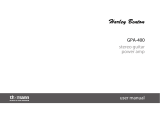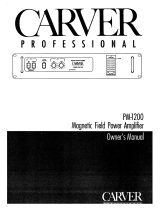Axxent AX4240TS User manual
- Category
- Audio amplifiers
- Type
- User manual
This manual is also suitable for

®
1
axxent e.K. · Technologiezentrum Herzbachtal · Zum Wartturm 15 · 63571 Gelnhausen
Fon: +49-6051-9165584 · Fax: +49-6051-9165585 · mail@axxent.de · www.axxent.de
axxent e.K. · Technologiezentrum Herzbachtal · Zum Wartturm 15 · 63571 Gelnhausen
Fon: +49-6051-9165584 · Fax: +49-6051-9165585 · mail@axxent.de · www.axxent.de
User manual
models AX4120TS / AX4240TS
professional 4 channel amplifier
Introduction
We are pleased that you have decided to purchase this
axxent high power amplifier. Please read the following
manual carefully, to reach best results.
Important Features
axxent „T“ or „TS“ series amplifiers have isolated constant
voltage outputs for loudspeakers or loudspeaker lines with
audio transformers. The model 4120TS and 4240TS may also
be used with low impedance outputs.
Four discreet audio channels with a common power supply
feature low impedance outputs down to four ohms, as well
as constant voltage outputs of 50-, 70-, or 100 volts.
On the following pages please find important operational hints
like the controls and knobs on the front- and the connectors
on the rear side of the amplifier.
contents
frontside controls ................. 2
rear side connectors ...... 3-4
fan speed jumper .................5

User manual
models AX4120TS / AX4240TS
2
axxent e.K. · Technologiezentrum Herzbachtal · Zum Wartturm 15 · 63571 Gelnhausen
Fon: +49-6051-9165584 · Fax: +49-6051-9165585 · mail@axxent.de · www.axxent.de
Front controls
There are four knobs on the left side. These are the gain con-
trols. It is possible to remove the knobs and to cover the holes
with caps that are supplied with the amplifier to prevent use
by unauthorized personnel.
Each gain control has three LED’s: 2 green and a 1 red one.
When switched on, the lower green LED lights. The middle
green LED shows existing audio input. The red LED indicates
excessive input audio level and that the automatic limiter
starts limiting the output signal.
To the right of the control knobs you find another three step
LED indication: yellow, yellow and red. The lower two yellow
LED’s indicate bridge mode of channels 1+2, or 3+4. Bridging
mode almost doubles the maximum power of the AX4120TS
of two channels and results in approximately 200 watt at 8
ohms impedance. The AX4240TS has approximately 400
watts per output pair in bridging mode. Please note that this
bridging mode is possible only with low impedance and not
with the constant voltage outputs.
The upper red LED shows that the amplifier is in protect
mode. When this LED is on, the amplifier is switched o and
only after a remedy of the cause it will operate again. Please
call your service engineer and do not try to open the amplifier.
It had been our intention to limit the amount of front panel
controls to avoid a possible misuse of the control elements.

User manual
models AX4120TS / AX4240TS
3
axxent e.K. · Technologiezentrum Herzbachtal · Zum Wartturm 15 · 63571 Gelnhausen
Fon: +49-6051-9165584 · Fax: +49-6051-9165585 · mail@axxent.de · www.axxent.de
Amplifier controls and connections, rear side
At the very left you see the robust power switch with on/o
indication. Below the power switch an IEC power connector
with integral fuse holder. The amplifier has no directly con-
nected power cable to facilitate easy removal of the power
amplifier in case of failure. The power cable is delivered with
the power amplifier. In case of failure, i.e. if no LED lights, the
fuse may be defective. Please call your service engineer then,
or, when you have a fuse 6.3 amp slow blow with size of 5 by
20 mm available, you may try to change it. Please switch o
the amplifier first!
Output connectors, constant voltage
To the right of the power switch you find four so-called “Eu-
ro-Bloc” connectors. These are for operation of 50 v, 70 v, or
100 v constant voltage. In most European countries, 100 v
operations are standard. The “Euro-Bloc” connectors may be
removed from their respective socket and cables with a small
screwdriver screwed on.
Output connectors, low impedance
At the very top of the amplifier you note black and red so-
called binding posts. These are the low impedance connectors.
You may connect loudspeakers direct to these binding posts
and the amplifier drives loads down to 4 ohms per output
channel. We recommend at very demanding use, i.e. very high
input signal to connect loads down to 8 ohms only. When you
intend to use both constant voltage outputs and the low im-
pedance output of a channel at the same time, we also recom-
mend not to go lower than 8 ohms. At 8 ohms operations you
have some power left for constant voltage operations.
When you operate the amplifier in bridge mode, please con-
nect your cable to the indicated black and red posts (+/-).

User manual
models AX4120TS / AX4240TS
4
axxent e.K. · Technologiezentrum Herzbachtal · Zum Wartturm 15 · 63571 Gelnhausen
Fon: +49-6051-9165584 · Fax: +49-6051-9165585 · mail@axxent.de · www.axxent.de
Input connectors
The input connectors are 3 pin xlr connectors, female. You find
them at the lower right. Inputs are electronically balanced and
have an input impedance of 20 kohms. All standard micro-
phone cables may be used for connection. Between input 4
and 3, as well as between input 2 and 1, you find a recessed
switch. These are used to activate bridge mode between these
channels.
Bridge mode
Only the low impedance outputs of the amplifier may be used
in bridge mode. In normal mode, the AX4120TS amplifier has
an output power of 120 w r.m.s. If you need higher power, you
may use, for example, channel 1+2 in bridge mode and there-
fore fore almost double the power. You will also double the
impedance, i.e. instead of 4 ohms, you then will have approxi-
mately 200 w at 8 ohms available. In this mode, you may not
use low impedance output and constant voltage outputs par-
allel. One of the advantages of bridge mode is: that with the
AX-4120TS amplifier, you may have 200 w at 8 ohms from, for
example, from channel 1 and 2, and two constant voltage lines
with 120 w of power from channel 3 and 4. This is only one of
many possible configurations of the amplifier.
Model AX4240TS has exactly twice the power stated with
the AX4120TS in all modes.

User manual
models AX4120TS / AX4240TS
5
axxent e.K. · Technologiezentrum Herzbachtal · Zum Wartturm 15 · 63571 Gelnhausen
Fon: +49-6051-9165584 · Fax: +49-6051-9165585 · mail@axxent.de · www.axxent.de
Fan ventilation
A fan is used to ventilate air from back to front and to cool inter-
nal components. In normal mode, the fan speed is controlled by
the heat sink temperature. If no input signal is present, the fan is
out or very low. If heat sink temperature is low, the fan is out or
turns very slow. If the heat sink temperature becomes higher,
then fan speed accelerates. This mode is recommended in all
applications where low fan noise is required, such as in churches
or conference rooms. If you feel that the operation in your appli-
cation is very critical, such as with constantly very loud music,
you may use the option of signal input control of the fan speed.
See the diagram above.
CE Conformity Declaration
We herewith declare in sole responsibility, that this product conforms to the
European EMC standard 89/336/EEC and to the requirements of the uniform
standard EN-55013 and EN-55020.
JUMPER S3
Switching to high speed fan mode is made by inserting a jumper connection inside the amplifier.
High speed fan mode (fan is controlled by signal input) may be desired with ultra high and
critical operational condition. Please find the location of this jumper S3 in the diagram above.
Please note that we recommend the jumper removal by a qualified technician.
-
 1
1
-
 2
2
-
 3
3
-
 4
4
-
 5
5
Axxent AX4240TS User manual
- Category
- Audio amplifiers
- Type
- User manual
- This manual is also suitable for
Ask a question and I''ll find the answer in the document
Finding information in a document is now easier with AI
Related papers
Other documents
-
TEAC Tascam Series 15 User manual
-
 Harley Benton Harley Benton GPA-400 User manual
Harley Benton Harley Benton GPA-400 User manual
-
Carel heaterSteam UR010 User manual
-
Niles Audio SI-1200 User manual
-
The box E-800 User manual
-
 Carver PM-1200 Owner's manual
Carver PM-1200 Owner's manual
-
Electro-Voice AP2800 Operating instructions
-
Mackie FR Series M-1400 Owner's manual
-
Mackie M2000/M3000/M4000 User manual
-
Niles Audio Stereo Amplifier SI-1260 User manual














